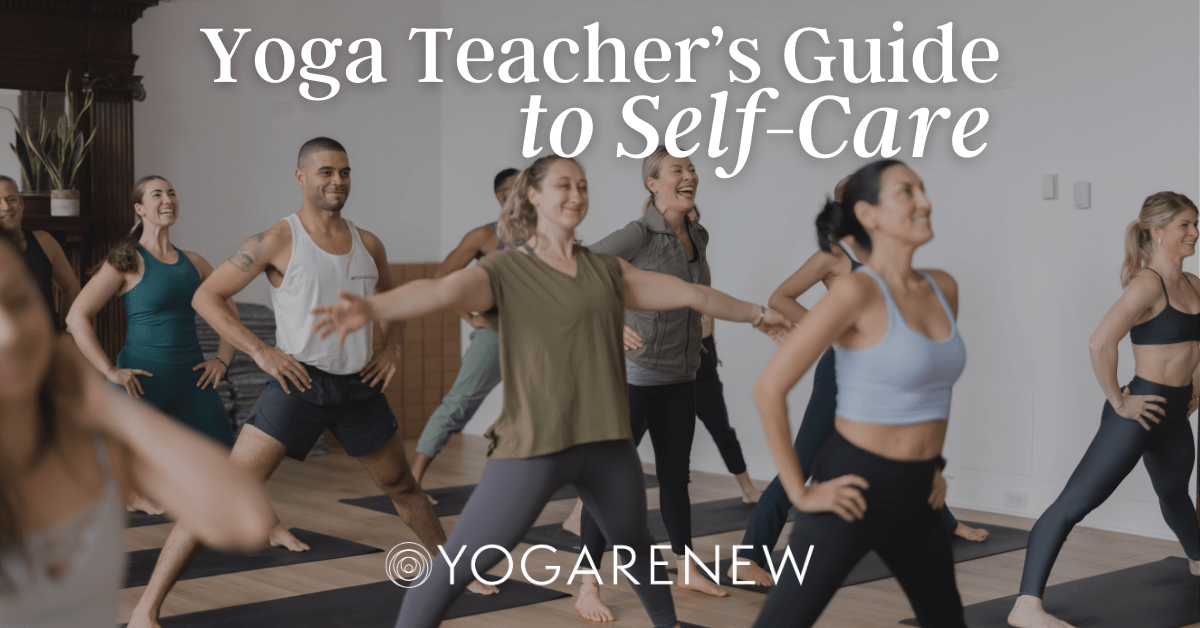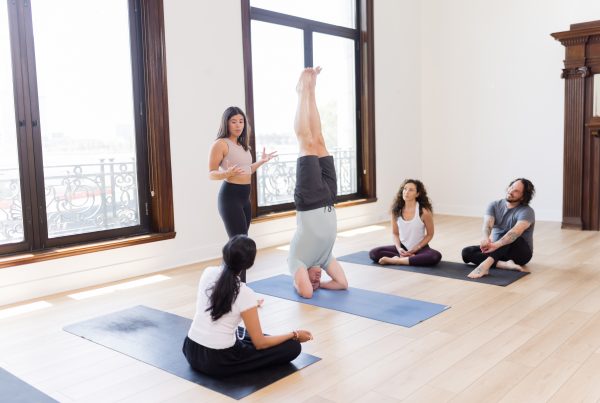
In the whirlwind of teaching, training, and guiding others, yoga teachers have to navigate through the ebbs and flows of inspiration and exhaustion. In the hustle of crafting sequences, leading classes, and embodying the principles of yoga, it’s easy to overlook the person most in need of care: yourself.
This guide is a tool for yoga teachers seeking to recalibrate, rejuvenate, and rediscover the joy in their practice and life. Drawing from Ayurveda, the ancient sister science to yoga, we will dive into practices designed to harmonize body, mind, and spirit, offering a path back to equilibrium and joy in teaching and living.
It’s way too easy to feel tired, burnt out, and unmotivated – or uninspired as a result of teaching too many classes, saying “yes” to too many things, and trying to just make rent, pay bills, and live your dream. I’ve experienced the burnout, the anxiety, and all of the things that come with pushing too hard and not setting boundaries. Now, I’m excited to share the tools that helped me stay in love with teaching and stay connected to what makes me happy and balanced.
Rediscovering Your Why: The Heart of Self-Care
You probably hear this a lot: “What is your ‘why?’”
If you haven’t heard it yet, you’re about to really hear it. Whenever you begin to make a living out of something you love, it’s incredibly important to remember why you love it and what keeps you coming back to it. It’s important to remind yourself what inspired you to try yoga and also how you felt when you first fell in love with it. You need to remember what keeps you coming back to the practice and also how you feel when you’re not practicing.
When you remember why you do what you do, you’re going to want to keep returning to it. It won’t feel like a chor or just something on a “to do” list that you need to check off. Once you tap into your “why”, it can serve as a reminder for why you actually want to keep showing up.
5 Essential Self-Care Tips for Yoga Teachers:
- Acknowledge Your Limits: Start by observing moments of fatigue or frustration. Use a journal to track these instances and seek patterns. Understanding your boundaries is the first step towards honoring them.
- Embrace Routine: Consistency is key. Select a few daily rituals—waking, eating, or sleeping at the same times—to anchor your day and signify that your well-being is a priority.
- Connect with Nature: Regular walks, especially in natural settings, can profoundly restore balance. Leave distractions behind and immerse yourself in the rhythm of the natural world.
- Learn to Say No: Asserting boundaries by declining requests that don’t serve you is not just okay—it’s necessary for preserving your energy and maintaining your integrity as a teacher.
- Deepen Your Practice: Remember to be a student first. Engage in workshops, classes, and trainings that fuel your passion. Let this exploration be a source of inspiration and renewal.
How Ayurveda Can Help a Yoga Teacher’s Self-Care Routine
Ayurveda offers a lens through which to view ourselves and the world in terms of the five elemental energies: earth, water, fire, air, and ether. These elements combine into three doshas: Vata, Pitta, and Kapha—that influence our physical, emotional, and mental tendencies. Recognizing your predominant dosha(s) can guide you in tailoring self-care practices that foster balance and well-being.
Understanding The Doshas:
- Kapha (Earth & Water): Stability, compassion, and nurturing are hallmarks of Kapha energy. When in balance, Kapha types are the grounding force in any setting.
- Pitta (Fire & Water): Organization, drive, and determination define Pitta. A balanced Pitta is a source of transformation and leadership.
- Vata (Air & Ether): Creativity, adaptability, and spontaneity are characteristic of Vata. In balance, Vata energies inspire innovation and exploration.

Vata, pitta and kapha doshas with ayurvedic icons of elements – ether, fire, air, water and earth. Banner, poster, design for yoga class. Used in Yoga, Ayurveda, Buddhism.
Practices to Cultivate Balance for Yoga Teachers
Sometimes “self care” can sound like too much work. You don’t actually need to have a long ritual with candles and incense to practice self care. Self care can look like sipping warm lemon water every morning or reminding yourself to thank your body while you take a shower every evening. Self care can also look like tapping into your own unique rhythms and acknowledging their wisdom.
Below are some suggestions to understand the concept of routine and also see what a routine can look like. If you’re inspired to try out any practices, begin with one of them and then build on that once it’s established.
Dinacharya: The Power of Routine
Ayurveda emphasizes the significance of aligning with nature’s rhythms through Dinacharya, or daily routine. This practice encourages adherence to natural cycles, promoting harmony and ease in daily life. Consider incorporating simple rituals that resonate with your dosha and lifestyle, aiming for consistency to build a resilient foundation for well-being.
Morning Rituals for Awakening:
- Rise with the sun to harness the energy of a new day.
- Practice oil pulling, tongue scraping, and eye cleansing with rose water for physical purification.
- Engage in gentle movement, meditation, or gratitude practices to set a positive tone for the day.
Mid-Day Practices for Nourishment:
- Make lunch your largest meal, eaten in a calm and mindful state.
- Integrate a short walk or nature connection post-meal to aid digestion and mental clarity.
Evening Rituals for Rest:
- Opt for a light dinner, allowing your digestive system to relax before sleep.
- Disconnect from electronics to unwind and prepare for rest.
- Engage in calming activities like meditation, reading, or a gentle self-massage to signal the body it’s time to rest.
Yoga Teacher’s Self-Care: Embracing Ayurveda in Your Life and Teaching

Dry brushing is a common Ayurvedic self-care practice that is perfect for yoga teachers to balance their doshas
The journey into Ayurveda and self-care is deeply personal and endlessly rich. As yoga teachers, integrating these practices offers not only personal balance but also enriches our teaching, allowing us to share from a place of groundedness and authenticity. The path of self-care is a continuous exploration, one that invites us to return to ourselves, to our why, and to the joy that originally called us to the mat and the teaching of yoga.
This exploration into Ayurveda and self-care for yoga teachers is more than a guide; it’s an invitation to get yourself on a journey of self-discovery, balance, and renewed passion for yoga and life. By prioritizing well-being, you not only enhance your own life but also enrich the lives of those you teach, leading by example and inspiring a culture of self-care within your communities.
Take a few moments right now to jot down how you currently feel. Be honest with yourself and use words that help you understand the current qualities of your current state. Once you make that list, take the time to reflect on it. How does it make you feel? If you aren’t happy with what you see, use this guide to help you make some small changes. The smaller the change, the easier it will be to stick with it. Once you find that you’ve stayed with a self care practice for longer than two weeks, you can begin to add more to your routine.

Cooking Ayurvedic meals is another great practice for self-care for yoga teachers.
One of the biggest mistakes people make with self care is adding too much too soon and also trying to make extreme changes immediately. This shocks their system and their minds and bodies think that it’s not what should be happening. When that occurs, it becomes way too easy to fall back into old habits and lose the ability to take care of yourself.
I hope this guide helps your find your rhythms and tap back into self love!










